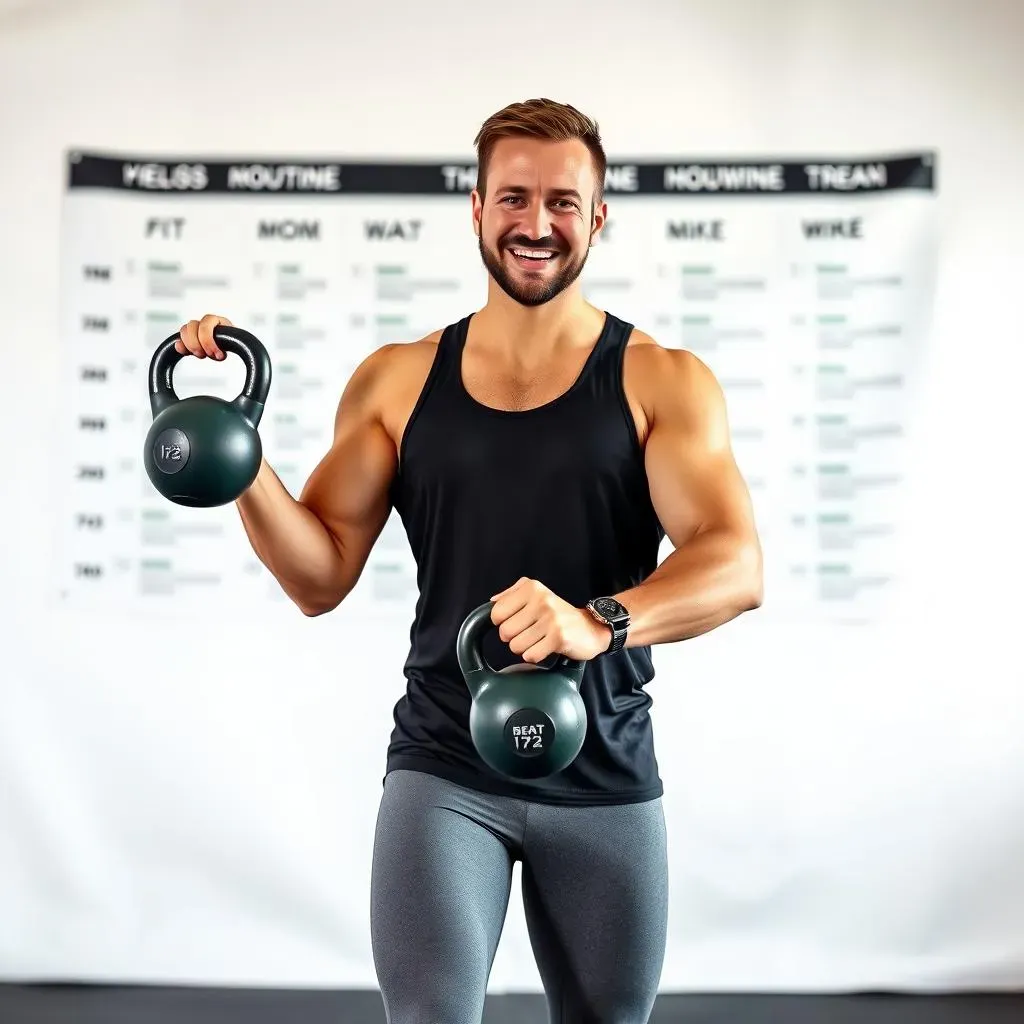Table of Contents
Ready to carve out a core of steel? Forget endless crunches – the secret weapon you've been overlooking might just be a kettlebell. This isn't your average ab workout; we're diving deep into the world of kettlebell core workout video routines that'll torch calories, build functional strength, and leave you feeling like a total badass. Whether you're a seasoned kettlebell enthusiast or a complete newbie, this guide is your roadmap to unlocking a stronger, more defined midsection.
Why Kettlebell Core Workouts Are a Game Changer

Why Kettlebell Core Workouts Are a Game Changer
More Than Just Crunches: The Core Truth
Let's be real, endless crunches get boring fast, and honestly, they're not the most effective way to build a strong, functional core. Kettlebell core workouts are a total game changer because they force your entire body to work as a unit. You're not just isolating your abs; you're engaging your glutes, back, and shoulders, creating a powerhouse of stability.
Think about it: every kettlebell exercise, from swings to Turkish get-ups, requires you to brace your core to control the weight and maintain proper form. This constant engagement builds strength and endurance in a way that traditional ab exercises simply can't match. It's about functional fitness, building a core that supports you in everyday life, not just one that looks good in a mirror.
Unlocking Functional Strength and Stability
One of the biggest advantages of kettlebell core workouts is the focus on functional strength. This means you're building strength that translates directly into real-world activities. Lifting groceries, carrying kids, or even just maintaining good posture – a strong core makes it all easier and reduces your risk of injury.
Kettlebells challenge your stability in unique ways. The offset weight forces your core to work harder to maintain balance, improving your proprioception (your body's awareness of its position in space). This enhanced stability not only makes you stronger but also more agile and coordinated.
Kettlebell Core vs. Traditional Core Workouts
So, how do kettlebell core workouts stack up against traditional exercises? Let's break it down:
Feature | Kettlebell Core Workouts | Traditional Core Workouts |
|---|---|---|
Muscle Engagement | Full-body, compound movements | Isolated muscle groups |
Functional Strength | High | Low to moderate |
Stability | Challenging, improves proprioception | Limited |
Calorie Burn | High, due to full-body engagement | Lower |
Boredom Factor | Lower, due to variety and challenge | Higher, repetitive movements |
The verdict? Kettlebell core workouts offer a more comprehensive and engaging approach to building a strong, functional core. They're not just about aesthetics; they're about improving your overall fitness and quality of life.
Essential Kettlebell Exercises for a RockSolid Core

Essential Kettlebell Exercises for a RockSolid Core
Kettlebell Swings: The King of Core
If there's one exercise that deserves the crown for core engagement, it's the kettlebell swing. This dynamic movement fires up your entire posterior chain – glutes, hamstrings, and back – while simultaneously forcing your core to stabilize your spine. Think of it as a moving plank, building strength and power with every rep. The swing isn't just about lifting the weight; it's about generating power from your hips and maintaining a tight, braced core throughout the entire movement. When done correctly, you should feel it working your abs and lower back like crazy.
A lot of people make the mistake of turning the kettlebell swing into a squat. It's a hip hinge, not a squat! Keep your back straight, engage your lats, and drive the movement with your hips. Imagine snapping a towel at the top of the swing. Master the hip hinge, and you'll unlock the true power of the kettlebell swing.
Turkish Get-Ups: The Ultimate Core Challenge
The Turkish get-up (TGU) is like a full-body puzzle that demands incredible core strength, stability, and coordination. This exercise takes you from lying on the ground to standing up, all while holding a kettlebell overhead. Every step of the TGU requires intense core engagement to maintain balance and control. It's a slow, deliberate movement that forces you to be present and focused, making it as much a mental challenge as a physical one.
Don't rush the TGU. Break it down into its individual components and master each step before linking them together. Start with a light weight and gradually increase it as you become more comfortable. Focus on maintaining a straight line from your wrist to your shoulder throughout the entire movement. If you can nail the TGU, you'll have a core that can handle anything.
Kettlebell Deadlifts: Building a Solid Foundation
While often thought of as a leg and back exercise, the kettlebell deadlift is also a fantastic core builder. The key is to maintain a neutral spine throughout the movement, which requires constant core engagement. Think of your core as a corset, wrapping around your torso and protecting your spine. As you lift the kettlebell, focus on squeezing your glutes and bracing your abs. The deadlift not only strengthens your core but also improves your posture and overall stability.
Make sure you're hinging at your hips and not rounding your back. Keep the kettlebell close to your body throughout the entire movement. Start with a weight you can comfortably control and gradually increase it as you get stronger. A strong deadlift is the foundation for many other kettlebell exercises, so it's worth spending the time to master it.
What weight should you use?
- Beginner: 12-16kg (26-35 lbs) for men, 8-12kg (18-26 lbs) for women
- Intermediate: 20-24kg (44-53 lbs) for men, 16kg (35 lbs) for women
- Advanced: 28-32kg+ (62-70+ lbs) for men, 20kg+ (44+ lbs) for women
Kettlebell Russian Twists: Targeting Your Obliques
If you're looking to carve out those obliques, kettlebell Russian twists are your go-to exercise. This rotational movement targets the muscles on the sides of your core, helping you build a more defined and functional midsection. The key is to maintain good posture and control the movement. Avoid rounding your back or using momentum to swing the kettlebell. Focus on squeezing your obliques with each twist.
Start with your feet on the ground and gradually progress to lifting them off the ground for an added challenge. You can also increase the weight of the kettlebell as you get stronger. Remember, quality over quantity. Focus on controlled movements and proper form to get the most out of this exercise.
Here's a reminder!
Kettlebell Windmills: Stability and Flexibility
The kettlebell windmill is a challenging exercise that combines core stability, shoulder mobility, and hamstring flexibility. This movement requires you to maintain a straight arm overhead while bending at your hips and reaching towards the ground with your opposite hand. The windmill forces your core to work overtime to stabilize your spine and prevent you from collapsing. It's a great way to improve your overall body control and coordination.
Start with a light weight and focus on maintaining proper form. Keep your eyes on the kettlebell throughout the entire movement. If you feel any pain in your shoulder or back, stop immediately. The windmill is a complex exercise that requires patience and practice. But with consistent effort, you'll reap the rewards of a stronger, more stable core and improved overall mobility.
Crafting Your Kettlebell Core Workout Video Routine

Crafting Your Kettlebell Core Workout Video Routine
Designing Your Perfect Workout
so you're ready to put together your own kettlebell core workout video routine? Awesome! First things first, think about your goals. Are you looking to build strength, improve endurance, or just get a more defined midsection? Your goals will dictate the exercises you choose and the rep ranges you use. It's also crucial to consider your current fitness level. Don't jump into advanced exercises right away. Start with the basics and gradually progress as you get stronger. Remember, consistency is key. Aim for at least 2-3 kettlebell core workouts per week to see results.
When designing your routine, think about incorporating a variety of exercises that target different areas of your core. Include exercises like kettlebell swings, Turkish get-ups, deadlifts, Russian twists, and windmills. This will ensure that you're working your entire core, not just your abs. Also, don't forget about warm-up and cool-down. A proper warm-up will prepare your body for the workout, while a cool-down will help you recover and prevent injuries. And most importantly, listen to your body. If you feel any pain, stop immediately.
Structuring Your Video for Maximum Impact
Alright, now let's talk about structuring your kettlebell core workout video for maximum impact. Start with a dynamic warm-up to get your blood flowing and your muscles ready for action. Follow this with your main workout, which should consist of 3-5 exercises performed for a specific number of reps or time. Then, finish with a cool-down to stretch your muscles and lower your heart rate. When it comes to reps and sets, there's no one-size-fits-all answer. It depends on your goals and fitness level. Here's a general guideline:
Goal | Reps | Sets | Rest |
|---|---|---|---|
Strength | 6-8 | 3-4 | 90-120 seconds |
Endurance | 12-15 | 2-3 | 60-90 seconds |
Definition | 10-12 | 3 | 60-90 seconds |
Make sure to include clear and concise instructions for each exercise, along with modifications for different fitness levels. This will make your video more accessible and engaging for a wider audience. And don't forget to add some personality! Let your enthusiasm shine through and make your video fun and motivating to watch.
Avoiding Mistakes in Your Kettlebell Core Workout Video

Avoiding Mistakes in Your Kettlebell Core Workout Video
Rushing the Process: Quality Over Quantity
One of the biggest mistakes people make when starting with kettlebell core workouts is rushing the process. They see those impressive kettlebell core workout video transformations online and want to jump straight into advanced exercises and heavy weights. But trust me, that's a recipe for disaster. Proper form is absolutely crucial when it comes to kettlebells, especially for core exercises. If you're not using the correct technique, you're not only reducing the effectiveness of the workout but also significantly increasing your risk of injury.
Start slow, master the fundamentals, and gradually progress as you get stronger. Focus on quality over quantity. It's better to do fewer reps with perfect form than to crank out a bunch of sloppy reps. Record yourself doing the exercises and compare your form to videos of qualified instructors. This will help you identify any areas where you need to improve. Remember, patience is a virtue. Building a strong, stable core takes time and consistent effort.
Ignoring the Warning Signs: Listen to Your Body
Another common mistake is ignoring the warning signs your body is sending you. Pain is never a good sign, especially when it comes to your core. If you feel any sharp or persistent pain during a kettlebell exercise, stop immediately. Don't try to push through it. It's better to err on the side of caution and rest than to risk a serious injury. Learn to differentiate between muscle soreness and actual pain. Soreness is a normal part of the training process, but pain is a sign that something is wrong.
Pay attention to your body's signals and adjust your workout accordingly. If you're feeling fatigued or run down, take a rest day. Don't try to do too much too soon. Gradual progression is key to avoiding injuries and staying consistent with your training. And don't be afraid to seek professional help if you're experiencing persistent pain. A qualified physical therapist or athletic trainer can help you identify the underlying cause of your pain and develop a plan to address it.
Symptom | Possible Cause | Action |
|---|---|---|
Sharp, sudden pain | Acute injury (e.g., muscle strain) | Stop immediately, seek medical attention |
Persistent dull ache | Overuse, inflammation | Rest, ice, consider physical therapy |
Muscle soreness after workout | Normal muscle adaptation | Light stretching, active recovery |
Wrapping Up Your Kettlebell Core Transformation
So, you've journeyed through the world of kettlebell core workouts, armed with the knowledge to sculpt a stronger, more resilient midsection. Remember, consistency is key. Incorporate these exercises and routines into your fitness regimen, focusing on proper form and gradual progression. Don't be afraid to experiment and find what works best for your body. With dedication and the power of the kettlebell, you're well on your way to achieving the core strength and definition you've always wanted. Now go crush those goals!